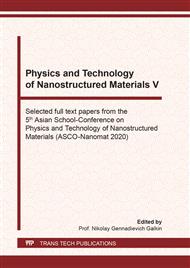[1]
R. Pandimurugan, S. Thambidurai, UV protection and antibacterial properties of seaweed capped ZnO nanoparticles coated cotton fabrics, Int. J. Biol. Macromol. 105 (2017) 788-795.
DOI: 10.1016/j.ijbiomac.2017.07.097
Google Scholar
[2]
M. Shaban, F. Mohamed, S. Abdallah, Production and characterization of superhydrophobic and antibacterial coated fabrics utilizing ZnO nanocatalyst, Sci. Rep. 8 (2018) 3925.
DOI: 10.1038/s41598-018-22324-7
Google Scholar
[3]
A.L. Mohamed, M.A. El-Sheikh, A.I. Waly, Enhancement of flame retardancy and water repellency properties of cotton fabrics using silanol based nano composites, Carbohydr. Polym. 102 (2014) 727-737.
DOI: 10.1016/j.carbpol.2013.10.097
Google Scholar
[4]
D. Goncharova, E. Gavrilenko, A. Nemoykina, and V. Svetlichnyi, Antibacterial activity of zinc oxide nanoparticles obtained by pulsed laser ablation in water and air, MATEC Web Conf. 243 (2018) 00017.
DOI: 10.1051/matecconf/201824300017
Google Scholar
[5]
R. Jalal, E.K. Goharshadi, M. Abareshi, M. Moosavi, A. Yousefi, P. Nancarrow, ZnO nanofluids: green synthesis, characterization, and antibacterial activity, Mater. Chem. Phys. 121 (2010) 198-201.
DOI: 10.1016/j.matchemphys.2010.01.020
Google Scholar
[6]
M. Rai, A. Yadav, A. Gade, Silver nanoparticles as a new generation of antimicrobials, Biotechnol. Adv. 27 (2009) 76-83.
DOI: 10.1016/j.biotechadv.2008.09.002
Google Scholar
[7]
A. Sirelkhatim, S. Mahmud, A. Seeni, N.H.M. Kaus, L.C. Ann, S.K.M. Bakhori, H. Hasan, D. Mohamad, Review on zinc oxide nanoparticles: antibacterial activity and toxicity mechanism, Nano-Micro Lett.7,3 (2015) 219-242.
DOI: 10.1007/s40820-015-0040-x
Google Scholar
[8]
G. Sangeetha, S. Rajeshwari, R. Venckatesh, Green synthesis of zinc oxide nanoparticles by aloe barbadensis miller leaf extract: structure and optical properties, Mater. Res. Bull. 46 (2011) 2560-2566.
DOI: 10.1016/j.materresbull.2011.07.046
Google Scholar
[9]
D. Zhang, B. Gökce, and S. Barcikowski, Laser synthesis and processing of colloids: fundamentals and applications, Chem. Rev. 117,5 (2017) 3990-4103.
DOI: 10.1021/acs.chemrev.6b00468
Google Scholar
[10]
V. Svetlichnyi, A. Shabalina, I. Lapin, D. Goncharova, A. Nemoykina, ZnO nanoparticles obtained by pulsed laser ablation and their composite with cotton fabric: preparation and study of antibacterial activity, Appl. Surf. Sci. 372 (2016) 20-29.
DOI: 10.1016/j.apsusc.2016.03.043
Google Scholar
[11]
E.A. Gavrilenko, D.A. Goncharova, I.N. Lapin, A.L. Nemoykina, V.A. Svetlichnyi, A.A. Aljulaih, N. Mintcheva, S.A. Kulinich, Comparative study of physicochemical and antibacterial properties of ZnO nanoparticles prepared by laser ablation of Zn target in water and air, Materials 12,186 (2019) 1-15.
DOI: 10.3390/ma12010186
Google Scholar
[12]
D.A. Goncharova, E.S. Savelev, I.N. Lapin, V.O. Trufanov, V.A. Svetlichnyi, Experimental equipment and methodology for testing the irradiation effect on the antibacterial activity of nanoparticles, 20th Int. Conf. of Young Special. on Micro/Nanotechnol. and Electron Devices, (EDM 2019) IEEE (2019) 601-605.
DOI: 10.1109/edm.2019.8823492
Google Scholar
[13]
U. Ozgur, Y.I. Alivov, C. Liu, A. Teke, M.A. Reshchikov, S. Dogan, V. Avrutin, S.J. Cho, H. Morkoç, A comprehensive review of ZnO materials and devices, J. Appl. Phys. 98 (2005) 041301.
DOI: 10.1063/1.1992666
Google Scholar
[14]
N. Padmavathy, R. Vijayaraghavan, Enhanced bioactivity of ZnO nanoparticles-an antimicrobial study, Sci. Technol. Adv. Mater. 9,3 (2008) 035004.
Google Scholar
[15]
J. Sawai, S. Shoji, H. Igarashi, A. Hashimoto, T. Kokugan, M. Shimizu, H. Kojima, Hydrogen peroxide as an antibacterial factor in zinc oxide powder slurry, J. Ferment. Bioeng. 86,5 (1998) 521-522.
DOI: 10.1016/s0922-338x(98)80165-7
Google Scholar
[16]
A. Phaniendra, D.B. Jestadi, L. Periyasamy free radicals: properties, sources, targets, and their implication in various diseases, Ind J Clin Biochem. 30,1 (2015) 11-26.
DOI: 10.1007/s12291-014-0446-0
Google Scholar


